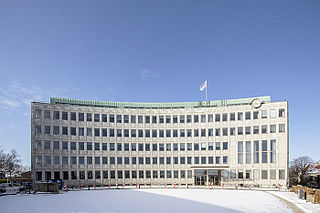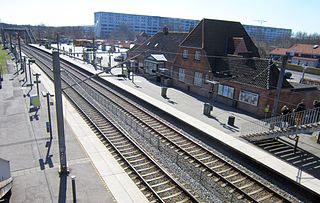
Hørsholm Municipality is a municipality in the Capital Region in the northern part of the island of Zealand (Sjælland) in eastern Denmark. The municipality covers an area of 31 km2, and has a total population of 24,811. Its mayor as of 2010 is Morten Slotved, a member of the Conservative People's Party.

Lyngby-Taarbæk Municipality is a municipality in the Capital Region of Denmark near Copenhagen on the eastern coast of the island of Zealand. It is part of the Greater Copenhagen area. The municipality borders Rudersdal Municipality to the north, Furesø Municipality to the west and Gladsaxe and Gentofte Municipality to the south. It borders the Øresund to the east.

Rudersdal Municipality is a part suburban, part rural municipality located on the northern outskirts of Copenhagen, Denmark. It covers an area of 73 km² and has a population of 57,237. The distance from Copenhagen City Hall Square is approximately 20 km. The western part of the municipality is served by the Hillerød radial of the S-train network while the eastern part is served by the Coast Line. Administratively Rudersdal Municipality belongs to Region Hovedstaden.

Kokkedal is the municipal seat of Fredensborg Municipality and a northern settlement in the urban area of Hørsholm, located on the coastline of northern Zealand, Denmark, between the two towns, Nivå and Hørsholm, 30 km north of Copenhagen. The settlement is connected with the Oresundtrain towards Helsingør to the north and Copenhagen to the south, with extensions to Malmö and other major cities in southern Sweden.
Trørød is a suburban district in Rudersdal Municipality, located approximately 20 kilometres north of central Copenhagen, Denmark. The original village has merged with the neighbouring communities of Vedbæk and Gammel Holte and now form the southernmost part of the urban agglomeration of Hørsholm. It is on the other sides surrounded by open farmland and the forests Jægersborg Hegn, Kohave Forest and Trørød Forest.

Fredensborg is a railway town located in Fredensborg Municipality, North Zealand, some 30 kilometres north of Copenhagen, Denmark. It is most known for Fredensborg Palace, one of the official residences of the Danish royal family. As of 1 January 2023, the town had a population of 8,960.

The Finger Plan is an urban plan from 1947 which provides a strategy for the development of the Copenhagen metropolitan area, Denmark. According to the plan, Copenhagen is to develop along five 'fingers', centred on S-train commuter rail lines, which extend from the 'palm', that is the dense urban fabric of central Copenhagen. In between the fingers, green "wedges" are intended to provide land for agriculture and recreational purposes.

North Zealand, also North Sealand, refers to the northern part of the Danish island of Zealand which is not clearly defined but generally covers the area north of Copenhagen. The Danish tourist authorities have recently introduced the term Danish Riviera to cover the area in view of its increasing importance for tourism. The area has three royal castles and offers resorts with beaches, as well as lakes and forests. In addition to Kronborg Castle, three of the North Zealand forest areas used for royal par force hunting are included in the UNESCO World Heritage List.
Sven Julius Risom was a Danish architect who worked mainly in the style of Nordic Classicism.
Rungsted, also known as Rungsted Kyst, is an affluent suburban neighborhood in Hørsholm Municipality on the Øresund coast north of Copenhagen, Denmark. The center of Hørsholm is located two kilometers west of Rungsted. At the Øresund coast is Rungsted Harbour, a marina.
Søllerød Naturpark is a protected area of rolling fields, meadows and small woods in Rudersdal Municipality, some 20 kilometres north of central Copenhagen, Denmark. It reaches from Søllerød Kirkeskov in the south to Høje Sandbjerg in the north. The area is state-owned and managed by the Danish Nature Agency.

Kvistgård is a small town in the southwestern outskirts of Helsingør, Helsingør Municipality, some 40 kilometres north of Copenhagen, Denmark. It is situated in the fork between the Helsingør Motorway to the east, separating it from Espergærde, and Helsingørsvej to the west. Kvistgård railway station is a stop on the Litte North railway line between Helsingør and Hillerød. As of 2023, Kvistgård has a population of 1,145.

The Par force hunting landscape in North Zealand is a collection of hunting grounds and forests north of Copenhagen. The landscape was submitted for admission to the UNESCO List of World Heritage Sites on 1 August 2010 and was inscribed on 4 July 2015. The landscape comprises three main areas: Store Dyrehave, Gribskov and Jægersborg Dyrehave/Jægersborg Hegn, and contains the most significant hunting grounds for the medieval nobility in Denmark. The central-star grid design of the landscape, with numbered roads and stone posts, fences, demonstrates the unique planning and design of hunting landscapes in the 17th and 18th centuries.

Secondary route 201 is a numbered road in North Zealand to the north of Copenhagen, Denmark, consisting of Lyngby Omfartsvej, a motorway bypass avoiding Lyngby Hovedgade, and Kongevejen which links Kongens Lyngby in the south with Hillerød in the north by way of Holte, Birkerød and Blovstrød. The road originates in a royal road which was built in 1587 between Copenhagen and Frederiksborg Castle, Frederick II's new North Zealand residence. The southern part of the road has now been replaced by Lyngbyvej and the southernmost portion of Helsingør Motorway.

Usserød Å, the principal drainage of Sjælsø Lake. is a stream in North Zealand to the north of Copenhagen, Denmark. It is approximately 9 kilometres long, drops 18 metres and is joined by Donse Å before itself flowing into Nive Å on its way to the Øresund at Nivå. It passes through the protected Usserød Ådal and the town of Hørsholm. Several watermills and early industrial sites are located along its course, the largest being Usserød Textile Mill.

Kokkedal Slot is a former country house located in Hørsholm north of Copenhagen, Denmark. It is now operated as a 62-room, high-end hotel under the name Kokkedal Slot Copenhagen to distinguish it from Kokkedal Slot in North Jutland. The hotel is a member of the Small Luxury Hotels of the World (SHL) network. It is surrounded by parkland and an 18-hole golf course.
Folehavegård is an 18th-century farmhouse in Hørsholm, Denmark. It has been owned by Karen Blixen's father Wilhelm Dinesen, as well as her younger sister Ellen Dahl, and was owned by the family for more than a hundred years. The main building, barn and stable are listed. Much of the land has been sold off. The remaining 35 hectares consist mostly of open farmland but adjoins the woodlands Folehaveskoven and Rungsted Hegn.

Sjælsø is a lake straddling the borders between the municipalities of Rudersdal, Allerød and Hørsholm in North Zealand to the north of Copenhagen, Denmark. Situated immediately to the north of the suburban town of Birkerød, it is surrounded by a mixture of farmland, pastures and small woodlands.
Vallerød is a former village and current neighbourhood in Hørsholm, Denmark. It is located in the parishes of Rungsted and Kokkedal. The greenspace Nattergaleengen separates Vallerød from the Hørsholm neighbourhood.

Folehaveskoven, or Folehave Skov, is a forest in Hørsholm on the northern outskirts of Copenhagen, Denmark. It is part of a complex of smaller woodlands which also comprises Rungsted Hegn to the north, Deputatvang and Øster Sandbjerg to the south. It is bisected by the east–west running Folehavevej and is to the east bounded by the Coast Line.





















